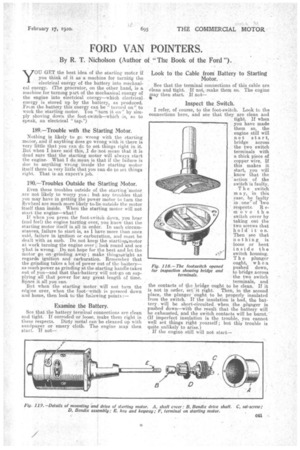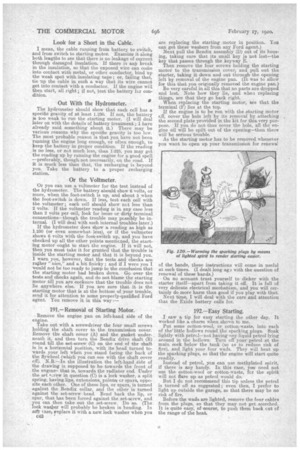FORD VAN POINTERS.
Page 25

Page 26

If you've noticed an error in this article please click here to report it so we can fix it.
By R. T. Nicholson (Author of "The Book of the Ford").
yOU GET the best idea of the starting motor if . you think' of it as a machine for turning the electrical energy of the battery into mechanical energy. (The generator' on the other hand, is 4, machine for turning part of the mechanical energy Of the engine into electrical energy—which electricalenergy is stored up by the battery, as produced. From the battery this energy can be "turned on" to work the starting motor. You "turn it on" by simply shoving down the foot-switch—which .is, so to speak, an electrical "tap.")
189.—Trouble with the Starting Motor.
Nothing is likely. to go wrong with the starting motor, and if anything does go wrong with it there is very little that you can do to set things right in it. But when I have said this, ,I donot mean that it is dead sure that the starting motor will always start the engine. What I do mean is that if the failure is due to anything wrong. inside the starting motor itself there is very little that you can do to set things right. That is an expert's job.
190.—Troubles Outside the Starting Motor.
Even these troubles outside of the. starting'inotor. are not likely to worry you ; but any troubles that you may have in getting the power motor to turn the flywheel are much more likely to-lie outside the motor itself than inside. When the starting motor will not start the engine—what?
If when you press the footswiteh down, you hear (and feel) the engine turning over, you know that the starting motor itself is all in order. In such circumstances, failure to start is, as I have more than once said, failure in ignition or carburation, and must be dealt with as such. Do not keep the startingmotor at work turning the engine over ; look round and see
what is wrong. Do not hope for the best and let the ,.
motor go on grinding away ; make thingsszight as regard's ignition and carburation. Remember that the grinding takes a lot of power out of the battery— as much poWer as grinding at the starting handle takes out of you—and that thatdbattery will not4go on supplying all that power for any great length of time. Spare it all you can.
But wheh the starting' motor will not turn the migine oyer, when the foot—witch is messed down and home, then look to the following points :
Examine the Battery.
See that the battery terminal connections arc clean and tight. If corroded or loose, make them right in these respects. Dirty metal can be cleaned up with sandpaper or 'emery cloth. The engine may then start. If not— Look to the Cable from Battery to Starting
Motor.
See that the terminal connections of this cable are clean and tight. -If not, make them so. The engine may then start. If not
•
Inspect the Switch.
I refer, of course, to the foot-switch. Look to the connections here, and see that they are clean and tight. If when you have made them so, the engine still will not start, bridge across the two switch terminals with a thick piece of copper wire. If this makes it start, you will know that the 'action of the switch is faulty.
T h e switch may, in this ease, be faulty in one' of two
respects. It emove the switch cover by taking out the two screws that hold it o n. Then see that nothing is loose or bent inside the switch housing. T h e plunger ought, when pushed down, to bridge across the two switch terminals, and the contacts of tbe bridge ought to be clean. If it is not in order, set. it right. Then, in the second place, the plunger ought to be properly insulated from the switch. If the insulation is bad, the battery will be short-circuited. when the plunger is pushed down—with the result that the 'battery will be exhausted, and the switch contacts will be burnt; (If imperfect insulation is the trouble, you cannot well set things right yourself ; but this trouble is quite unlikely to arise.) If the engine still will not start—
Fig. 118.—The footswitch opened for inspection showing bridge and terminals.
Look for a Short in the Cable.
I mean, the cable running from battery to switch, and from switch to starting motor. Examine it along both leag-ths to see that there is no leakage of current through damaged insulation. If there is any break in the insulation, so that the exposed wire can coffie into contact with metal, or other conductor, bind up the weak spot withinsulating tape ; or, failing that, tie up the cable in such a way that its wire cannot get into contact with a conductor. If the engine will then start, all right ; if not eest the battery for condition.
Out With the Hydrometer.
The hydrometer should show that each cell has a specific gravity of at least 1.250. If not, the battery is too weak to run the starting motor. (I will deal later on with the details of battery treatment; I have already said something about at.) There may be various reasons why the specific gravity is too low. The most probable reason is that you have not been running the engine long enough, or often enough, to keep the battery in proper condition. If the reading is no less, or not much less than 1.225, you may get the reading up by running the engine for a good spell —preferably, though not necessarily, on the road. If it is much less than that, the recharging is beyond you. Take the battery to a proper recharging station.
Or the Voltmeter.
Or you can use a voltmeter for the test instead of the hydrometer. The battery should show 6 volts, or more, when the foot-switch is up, and about 5 when the foot-switch is down. If less, test each cell with the voltmeter ; each cell should show not less than 2 volts. If the voltmeter reading is in any case less than 2 volts per cell, look for loose or dirty terminal connections—though the trouble may possibly be internal. (I will deal with such internal troubles later.) If the hydrometer does show a reading as high as 1.250 (or even somewhat less), or if the voltmeter shows 6 volts with the foot-switch up, and you have checked up all the other points mentioned, the starting motor ought to start the engine. If it will not, then you must take it for granted that the trouble is inside the starting motor and that it is beyond you. I warn you, however, that the tests and checks arc rather "nice," and a bit finicky ; and if I were you would not be too ready to jump to the conclusion that the starting motor had broken down. Go over the testa and checks again, and do not blame the starting motor till you are cocksure that the trouble does not lie anywhere else, if you are sure that it is the starting motor that is at the bottom of your trouble, send it for attention to some properly-qualified Ford agent. You remove it in this way
191.—Removal of Starting Motor.
Remove the engine pan on left-hand side of the engine.
Take out with a screwdriver the four small screws holding the shaft cover to the transmission cover. Remove the shaft cover (A) and the gasket underneath it, and then turn the Bendix drive shaft (B) round till the set-screw (Cl) on the end of the shaft is in a horizontal position, with its head turned towards your left when you stand facing the back of the flywheel (which you can see with the shaft cover off). N.B.—In the illustration the left-hand Side of the drawing is supposed to be towards the front of the enginethat is, towards the radiator end. Under the set eerew in question (C) is a, lock washer, a split spring, having lips, extensions, points e cr spurs, opposite each other. One of these lips, or spurs, is turned against the Bendix collar, and the other is turned against the set-screw head. Bend hack the lip, or spur, that has been forced against the -set-screw, and you can then take out the set-screw. Do so. (The lock washer will probably be broken in bending. In arty case; r eplace it with a new, lock washer when you C42 are replacing the starting motor in position. You can get these washers from any Ford agent.) Next pull the Bendix assembly (1)) out of its housing, taking care that its small key is not lost—the key that passes through the keyway E. Then remove the four screws holding the starting motor to the transmission cover, and pull out the starter, taking it down and out through the opening left by removal of the engine pan. (It was to allow for this that you originally removed the engine pan) Be very careful in all this that no parts are dropped and lost.. Note how they lie, and whea replacing things, see that they go back right. When replacing the starting motor, eee that the terminal (F) lies at the top. If the engine is to be run with the starting motor cff, cover the hole left by its removal by attaching the second plate provided in the kit for this very purpose. If you. do not thus cover the hole, all the engine oil will be spilt out of the opening—then there will be serious trouble.
As the starting motor has to be removed whenever you want to open up your .transmission for renews: of the laanda, these instructions will come in useful at such times. (I dealt long ag) with the auestion of renewal of these bands.) On no account trust yourself to dicker with the starter itself—apart from taking it off. It is full of very delicate electrical mechanism, and you will certainly do more harm than good if you play with that. Next time, I will deal with the care and attention that the Exide battery calls for.
I92.—Easy Starting.
saw a tip for easy starting the other day. It worked like a charm when shown to me.
Put some cotton-wool, or cotton-waste, into each of theelittle hollows round the sparking plugs. Soak lightly with petrel—not having eny liquid petrol lying around in the hollows. Turn off your petrol at the main cook below the tank (so as to reduce risk of fire), and light your four wads. They will heat up the sparking plugs, so that the engine will start quite readily.
Instead of petrol, you can use methylated spirit, if there is any handy. In this case, you need not use the cotton-wool or cotton-waste, for the spirit will not flare up as petrol would do.
But I do not recommend this tip melees the petrol is turned off as suggested; even then, I prefer to light up outside the garage, so that there may be no risk of fire.
Before the wads are lighted, remove the four cables from the plugs, so that they may not get scorched. It is quite easy, of course, to push them back cut of the range of the heat.




























